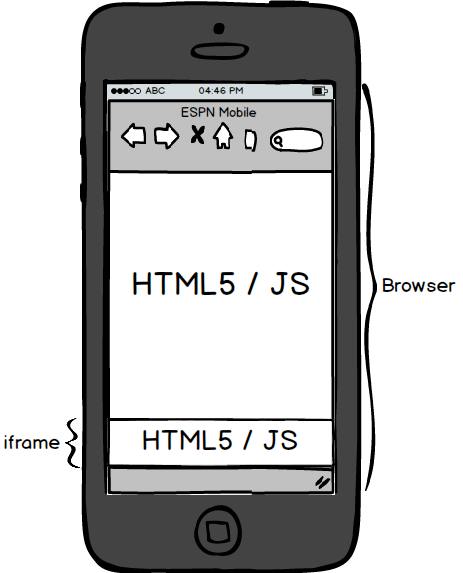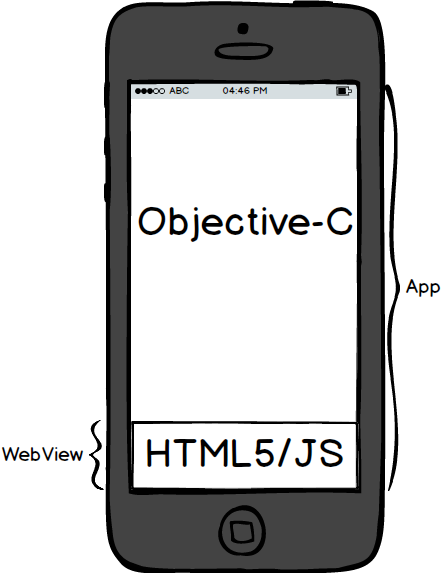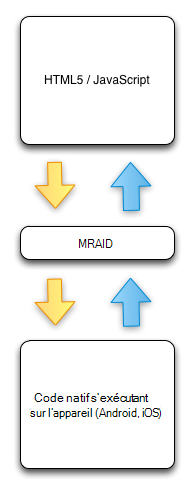MRAID and mobile video tutorial
This page offers an introduction to MRAID and mobile video. It attempts to answer questions such as:
- What is MRAID? How does it work, and how do I use it?
- What is the relationship between MRAID and mobile video?
- What are the different ways to run mobile video?
- What are the video capabilities of mobile web vs. in-app advertising?
MRAID
In this section we'll talk about what MRAID is and what it can do in combination with HTML and JavaScript. We will also talk about what MRAID is not.
MRAID definition
MRAID is often used as a buzzword to describe mobile rich media creatives. In reality, MRAID is a technology designed for a specific use case (in-app advertising) with some specific functionalities. This overview will help you get a better understanding of this technology. After reading this page you should be able to answer questions like:
- Does Xandr support MRAID?
- Do I need MRAID for this behavior?
- Can I run an MRAID creative on this inventory?
IAB's MRAID description
MRAID, or “Mobile Rich Media Ad Interface Definitions” is the IAB Mobile Marketing Center of Excellence’s project to define a common API (Application Programming Interface) for mobile rich media ads that will run in mobile apps . This is a standardized set of commands, designed to work with HTML5 and JavaScript , that developers creating rich media ads will use to communicate what those ads do (expand, resize, get access to device functionalities such as calendar events, etc) with the apps they are being served into.
Let's review the parts marked above in bold:
- Common API - MRAID is a common command set that creative developers may use. All apps that support MRAID support the same common commands so any creative that uses an MRAID feature will run correctly in different apps and different devices using the same creative code.
- Mobile rich media ads that will run in mobile apps - MRAID is only relevant for mobile rich media creatives that run in an in-app environment. MRAID is not relevant for mobile web environment.
- Designed to work with HTML5 and JavaScript - MRAID is not designed to replace HTML5 and JavaScript. It is designed to allow creatives that use JavaScript to interact with the native operating system that is running the app in which the creative is shown.
Note
All content in this document refers to MRAID 2.0. You can download the full spec from here.
MRAID use cases
To explain the need for MRAID, we need to examine the two main use cases in which ads are shown on mobile devices; Mobile Web and In-App. There is a fundamental difference in the technologies involved in both cases, and that difference creates the need for MRAID.
Mobile web
Mobile web is practically identical to desktop web. Mobile web sites run the same HTML5 and JavaScript code that desktop sites run, with some mobile optimized design. This means that mobile web inventory is an ad sized iframe (web page) running in a full sized web page:

In mobile web, the ad and the container it's running in (the browser) both "speak" HTML5/JS, so they can communicate freely with each other. The creative can ask the web page to perform actions on the iframe such as change its size (expand).
In-App
In-app inventory is fundamentally different from mobile web, because the app in which the the creative is displayed is not running HTML5 and JavaScript. Instead, it is running the native code of the devices operating system (Objective-C for iOS, Java for Android). The creative is displayed in a container called a WebView, which is a fully functional, ad sized web page that is running HTML5 and JavaScript:

In this case, the creative and the container it's running in (the app) cannot speak to each other, because the creative only speaks HTML5/JS and the app only speaks Objective-C or Java. This is where MRAID comes in. MRAID defines a set of commands that allows the creative to use JavaScript to communicate with the native code of the app and ask it to perform various actions.
The diagram below illustrates the relationship between the creative that is using HTML5/JS, MRAID, and the app that is running in native code.

The main thing to remember is that HTML5/JS and MRAID are not mutually exclusive technologies. MRAID was designed so that creatives can use HTML5/JS to communicate with native mobile apps.
MRAID functionality
The main functionality of MRAID is to allow a creative that is running on In-App inventory to change its size, get information about its position on the screen and about the screen size. There are additional functions that allow the creative to store photos in the device memory, create a calendar event, and access the native video player.
Below is a list of all the methods available in the API defined by MRAID, grouped by functionality:
| Methods used for size change / expansion | Other UI functionality | Non UI functionality |
|---|---|---|
| - close - expand - resize - getCurrentPosition - getDefaultPosition - getMaxSize - getResizeProperties - getScreenSize - getState - setExpandProperties - setResizeProperties - useCustomClose |
- open - createCalendarEvent - playVideo - storePicture |
- addEventListener - getPlacementType - getVersion - isViewable - removeEventListener - supports |
It's easy to see that a full 50% of the methods defined by MRAID relate to size changes. This is a direct result of the inability of the creative to directly communicate with the app the way it does with the browser on mobile and desktop web.
Based on the methods listed above, there are four things MRAID does that the user can see:
- MRAID lets the creative change its size and ask for information regarding the screen size, its position on screen and whether it's currently viewable.
- MRAID lets creatives access the device's native video player.
- MRAID lets creatives store photos in the device's permanent memory.
- MRAID lets creatives access the calendar to create calendar events.
MRAID summary
All the other fancy stuff that you may have seen mobile rich media creatives do like drawing, games, and sounds is done in HTML5 and JavaScript. That behavior is not the result of MRAID. The reason why these creatives are often referred to as MRAID creatives is that MRAID has become a synonym for "Mobile Rich Media" creative. The reason for that is that these creatives usually need to expand to reveal this additional functionality, and in order to expand they need to use MRAID.
- All creatives that use the MRAID API are mobile, in-app, rich media creatives.
- Not all mobile rich media creatives use the functionality provided by MRAID (For example, creatives running in mobile web).
Mobile video
There are several ways to play a video on a mobile device, each with its own capabilities and behaviors. You can see how MRAID and HTML5 videos behave by loading placement ID 2579103, size 300x250, in the SDK app. The code for each creative is described below.
Advertising SDK
Before we continue, a few words about the term "Advertising SDK" used below. A Software Development Kit (SDK) is a piece of code that makes it easy for app developers to show ads in their apps. The two main roles Advertising SDKs perform are:
- Handle communications with the ad server and display the ad in the space allocated by the app (the WebView).
- Implement the MRAID API
For more information about our mobile SDKs, see Xandr Mobile SDKs
MRAID video
This is actually the simplest way to auto-play a video, but it has a significant drawback because it is impossible to define a click on the video. That is, users cannot click the video and be redirected to the advertiser's website. The reason for this drawback is that using MRAID to play a video opens the video in the device's native player, which is not a web page and therefore does not support clicks. This is why when you click a video being played using MRAID, you see the player controls. Below is a simple working example of an MRAID video of a dog:
<script src="mraid.js"></script>
<script type="text/javascript">
mraid.addEventListener('ready', function() {
mraid.playVideo("http://v.madnxs.com/p/e0/16/69/e6/e01669e619d6424f6b7e4597092764e3.m4v")
});
</script>
HTML5 video
One thing all mobile ads have in common is that they run in actual web browsers. Both the iFrame in a mobile web page and the WebView running in a native mobile app are fully functional web browsers, and therefore have full HTML5 support. HTML5 supports playing video in the browser without requiring an external player. However, iOS and Android have different behaviors and implementations for HTML5 video. Below is sample code of a working HTML5 video of a cat.
<body>
<video id="videoAd" width="300" height="250" autoplay controls muted webkit-playsinline poster="http://cdn.adnxs.com/p/20/0e/21/96/200e2196675e9ca10e89f5b63c127935.png" onclick="click_thru">
<source src="http://v.madnxs.com/p/23/35/06/3b/2335063b4a2d9871922f60bca7d97a66.m4v" type="video/mp4">
Your browser does not support the video tag.
<script type="text/javascript">
//code to *handle* click event on Android and iOS
function click_thru() {
document.getElementbyId("videoAd").pause();
window.open("http://www.appnexus.com");
}
//code to *catch* the click event on iOS
document.getElementById("videoAd").addEventListener('touchstart', click_thru);
</script>
</video>
</body>
Potential complications with HTML5 video
Devices running Android 4.4+ or iOS 6+ do not allow HTML5 videos to autoplay by default. This means developers have to add the
controlsattribute to the<video>element so that the video player shows the play/pause, seek bar, and mute controls so that the user can initiate and interact with the video. While autoplay behavior can be controlled by the advertising SDK that is running in the app, it will not solve the case for Mobile Web inventory, and does not promise consistent behavior for the creative across different apps running different advertising SDKs.Note
The Xandr SDK supports autoplay for HTML5 videos, which is the behavior you will see when using the SDK app. However, a mobile browser on the same device will not autoplay the video.
Full screen iPhone and iPad videos do not support click-through because they run in the device's native video player and not in a web browser (an iFrame / WebView). Android devices do support clicks on full screen videos.
It is possible to use click through for a creative running in an in-app environment on iPhones only by not allowing the video to go full screen. This requires adding the
webkit-playsinlineattribute to the<video>element, and enabling inline playback in the advertising SDK. This implementation is not standard and does not promise consistent behavior for the creative across different apps running different advertising SDKs.Android phones and tablets and iPads play HTML5 videos inline by default, so no change is required to use click-through functionality.
It is not possible to autoplay HTML5 videos in mobile web inventory in both Android and iOS at the same time.
Embedded video players
This is the most versatile option. Keep in mind that it is SDK-dependent and not standard. If the advertising SDK that is running in the app includes a video player, then the advertising SDK can direct the mraid.playVideo() call to that player, and include a click URL in it. However, because this API is not defined in MRAID, there is no guarantee that the ad will run the same way across different apps.